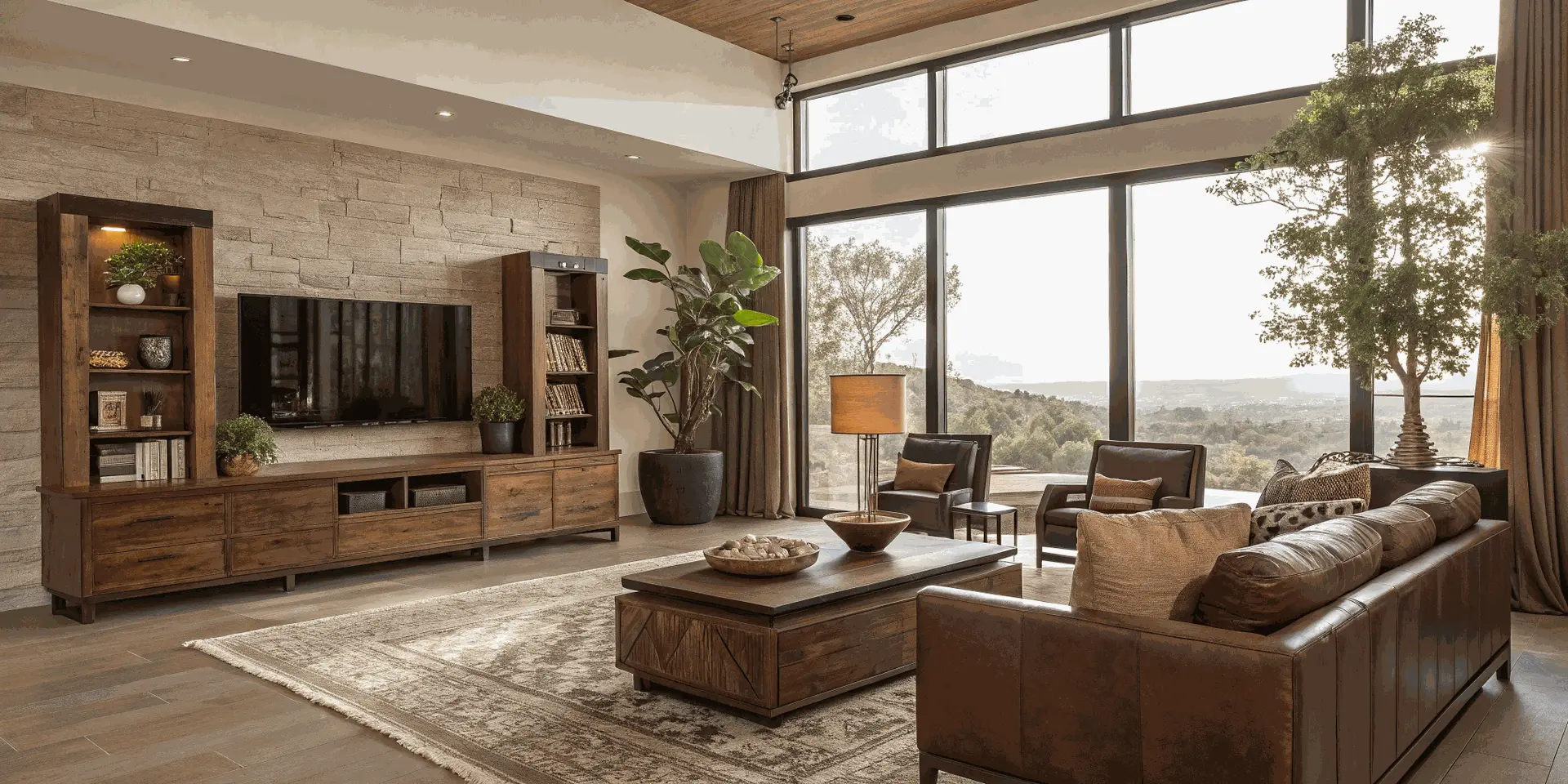Luxe Sustainable Living
I still remember the moment I realized my definition of luxury was completely backwards.
It was standing in my friend Sarah's Brooklyn brownstone last spring, running my hand across her dining table, a gorgeous piece of reclaimed walnut that had been crafted by a local artisan. The wood felt warm, almost alive under my fingertips, with grain patterns that told stories of decades of growth. Meanwhile, my own glass dining table at home (bought on sale from a big-box store) had already developed chips and scratches after just two years.
That's when it hit me: true luxury isn't about having the most expensive things. It's about having the right things, pieces that get better with time, support the people who made them, and don't leave you feeling guilty about their impact on the planet.
Welcome to the world of luxe sustainable living, where elegance meets ethics, and where your home becomes a sanctuary that nurtures both you and the environment.
What Is Luxe Sustainable Living?
Luxe sustainable living represents a fundamental shift in how we think about luxury. Gone are the days when opulence meant excess, waste, and environmental disregard. Today's discerning homeowners are discovering that true sophistication lies in thoughtful choices—investments in quality over quantity, craftsmanship over mass production, and longevity over trends.
This approach to living luxuriously while minimizing environmental impact has gained serious momentum. According to recent market research, the global sustainable luxury goods market is projected to reach $15.5 billion by 2030, driven by consumers who refuse to choose between style and sustainability.
But here's what makes this movement so compelling: luxe sustainable living isn't about sacrifice. It's about enhancement. When you choose a hand-woven wool rug over synthetic carpeting, you're not just reducing microplastic pollution—you're bringing texture, warmth, and timeless beauty into your space. When you invest in energy-efficient appliances, you're not just cutting emissions—you're creating a quieter, more comfortable home while slashing your utility bills.
The Three Pillars of Modern Sustainable Luxury
Quality & Longevity: The Art of Buying Once
The first pillar of luxe sustainable living is understanding that quality is the ultimate luxury. I learned this lesson the hard way through my kitchen knife collection (or rather, my kitchen knife graveyard). After going through five different "affordable" chef's knives in three years, I finally invested in a high-carbon steel Japanese blade from a respected craftsman.
Three years later, that knife is sharper than ever, develops a beautiful patina with use, and has transformed my cooking experience. The math is simple: one $200 knife that lasts 20+ years beats buying $40 knives every few years.
This principle extends throughout your home:
Furniture That Ages Gracefully
- Solid wood pieces that can be refinished and reupholstered
- Metal frames made from recycled aluminum or steel
- Natural stone surfaces that develop character over time
Textiles Built to Last
- Linen bedding that becomes softer with each wash
- Wool rugs that resist stains and wear
- Organic cotton upholstery with removable, washable covers
Transparency & Provenance: Knowing Your Story
The second pillar is about understanding the journey of every item in your home. Modern luxury consumers want to know: Who made this? Where did the materials come from? What was the environmental cost?
This isn't just about ethics—it's about connection. When you know that your dining table was crafted by Maria, a third-generation woodworker in Vermont using locally sourced maple, you develop an entirely different relationship with that piece. It becomes part of your home's story, something worth caring for and passing down.
Look for these transparency markers:
- Environmental Product Declarations (EPDs) that quantify carbon and water impacts
- Certifications like FSC for wood, GOTS for textiles, and GREENGUARD for indoor air quality
- Brands that publish their supply chain information
- Local artisans and makers who can tell you exactly how your piece was created
Wellness & Non-Toxic Living: Luxury You Can Feel
The third pillar recognizes that true luxury should make you feel better, not worse. Your home's air quality, lighting, acoustics, and material choices all contribute to your daily well-being in ways that are often invisible but always impactful.
Indoor Air Quality as a Luxury Service
Most people don't realize they're living with compromised air quality until they experience the alternative. When I renovated my bedroom using zero-VOC paints, formaldehyde-free furniture, and natural fiber textiles, the difference was immediately noticeable. The space felt cleaner, I slept better, and that subtle "new furniture smell" that I'd always accepted as normal completely disappeared.
Natural Light and Circadian Health
Investing in larger windows, skylights, or high-quality LED lighting systems that mimic natural light patterns isn't just about aesthetics—it's about supporting your body's natural rhythms and improving your energy levels throughout the day.
Room-by-Room Guide to Luxe Sustainable Living
The Kitchen: Where Sustainability Meets Daily Ritual
Your kitchen is the heart of sustainable luxury living. It's where small daily choices compound into significant environmental and health impacts over time.
The Induction Revolution
If I could convince every homeowner to make one upgrade, it would be switching to induction cooking. After years of struggling with uneven gas flames and slow electric coils, my induction cooktop changed everything. Water boils in half the time, temperature control is precise to the degree, and there are no combustion byproducts affecting indoor air quality.
The efficiency gains are remarkable—induction transfers 85% of energy to your food compared to 40% for gas. For a cooking enthusiast, this isn't just about sustainability; it's about performance.
Materials That Work Harder
- Countertops: Honed natural stone or recycled composite surfaces hide scratches and develop character over time
- Cookware: A curated collection of tri-ply stainless steel, enameled cast iron, and carbon steel that will outlast you
- Storage: Glass containers and ceramic crocks that eliminate plastic contact with food
The Bedroom: Your Sustainable Sanctuary
Your bedroom should be your most restful, rejuvenating space—and that means being thoughtful about every material that touches your skin and every element that affects your sleep quality.
The Textile Revolution
Natural fibers aren't just better for the planet; they're better for your body. Linen sheets regulate temperature naturally, preventing those middle-of-the-night wake-ups from overheating. Organic cotton and TENCEL™ lyocell offer silky softness without synthetic treatments that can irritate sensitive skin.
I replaced my polyester-blend sheets with Belgian linen two years ago, and the difference in sleep quality was immediate. The temperature regulation alone has reduced my need for air conditioning during summer months.
The Mattress Question
Natural latex mattresses with organic cotton and wool batting eliminate the flame retardants and synthetic foams found in conventional options. Yes, they're an investment—expect to pay $2,000-$4,000 for a quality natural mattress—but they typically last 20+ years compared to 7-10 for conventional mattresses.
The Living Room: Comfort Without Compromise
This is where your sustainable luxury philosophy gets tested by real life. Can beautiful, eco-conscious furniture hold up to daily use, kids, pets, and entertaining?

The Sofa Investment
A well-made sofa frame should last 15-20 years with proper care. Look for:
- Kiln-dried hardwood frames (avoid particle board)
- Eight-way hand-tied springs or high-quality sinuous springs
- Natural or recycled fill materials
- Removable, washable covers in performance fabrics
My current sofa, made by a North Carolina company using FSC-certified maple and organic cotton upholstery, has survived two moves, three cats, and countless dinner parties while looking better than the day I bought it.
Lighting as Wellness Technology
Layered lighting on dimmer switches isn't just about ambiance—it's about supporting your circadian rhythms. Warm, dim lighting in the evening signals your body to produce melatonin, while bright, cool light during the day maintains alertness and energy.
The Wardrobe: Capsule Luxury and Circular Fashion
Sustainable luxury extends beyond your home to your personal style. The most elegant wardrobes aren't the largest—they're the most thoughtfully curated.
Building Your Foundation
Start with timeless, high-quality basics that can be mixed, matched, and layered:
- A perfectly tailored blazer in a versatile fabric
- Well-fitting jeans from a brand committed to sustainable denim production
- Cashmere or merino wool knits that improve with age
- Leather shoes that can be resoled multiple times
The Fit Revolution
Here's a secret from the fashion industry: a $200 garment that fits perfectly looks more expensive than a $2,000 piece that doesn't. Developing a relationship with a skilled tailor is one of the best investments you can make in your wardrobe's longevity and your confidence.
Care Rituals as Self-Care
Taking proper care of your clothes—using mesh bags for delicates, air-drying instead of machine drying, treating stains immediately—extends their lifespan dramatically while creating mindful moments in your routine.
The Technology Integration: Smart, Efficient, Invisible
Sustainable luxury homes use technology to enhance comfort while reducing environmental impact, but the best systems are nearly invisible.
Climate Control That Learns
Smart thermostats with occupancy sensing and learning algorithms can reduce energy consumption by 10-15% while maintaining perfect comfort levels. The luxury is coming home to the ideal temperature without waste or thought.
Energy Monitoring as Mindfulness Practice
Whole-home energy monitors help you understand your consumption patterns and celebrate improvements. There's something deeply satisfying about watching your solar panels generate more electricity than your home consumes on a sunny day.
The Financial Reality: Investment vs. Expense
Let's address the elephant in the room: sustainable luxury requires upfront investment. But here's what I've learned after three years of transitioning to this lifestyle—the math works out in your favor.
Total Cost of Ownership
- A $3,000 natural mattress lasting 20 years costs $150 annually
- A $300 conventional mattress lasting 8 years costs $37.50 annually
- Factor in the health benefits of better sleep, and the premium pays for itself
Energy Savings
My home energy retrofit (insulation, windows, heat pump) cost $35,000 but reduced my annual utility bills by $2,400. In my climate, that's a 15-year payback, but I'm already enjoying the improved comfort daily.
Resale Value
Sustainable features increasingly command premium resale prices. Homes with solar panels, efficient HVAC systems, and non-toxic finishes sell faster and for higher prices in many markets.
Common Mistakes (And How to Avoid Them)
After helping dozens of friends transition to sustainable luxury living, I've seen the same mistakes repeatedly:
Mistake #1: All-or-Nothing Thinking
You don't need to replace everything at once. Start with high-impact areas where you'll notice the difference most—bedroom textiles, kitchen appliances, or lighting systems.
Mistake #2: Focusing Only on Materials
A bamboo cutting board made in a factory with poor labor practices isn't truly sustainable. Consider the entire lifecycle, including manufacturing conditions and transportation.
Mistake #3:
Sometimes the most sustainable choice is the pottery studio down the street, not the "eco-friendly" brand shipped from across the country.
Your 90-Day Transformation Plan
Ready to begin your luxe sustainable living journey? Here's a practical roadmap I've developed through trial, error, and lots of research:
Days 1-30: Assessment and Quick Wins
- Conduct a home inventory focusing on items you use daily
- Replace high-use light bulbs with dimmable LEDs
- Switch to natural cleaning products
- Start a relationship with a local tailor
Days 31-60: Strategic Upgrades
- Invest in one significant appliance upgrade (induction cooktop or energy-efficient dishwasher)
- Replace synthetic bedding with natural fibers
- Commission one local artisan piece
- Begin composting
Days 61-90: System Building
- Install a smart thermostat and energy monitoring
- Create a quarterly maintenance calendar for your investments
- Establish relationships with repair professionals
- Plan your next major upgrade
The Ripple Effect: How Your Choices Create Change
Here's what I find most exciting about luxe sustainable living: your personal choices create market signals that drive broader change. When enough consumers demand transparency, durability, and environmental responsibility, entire industries shift to meet that demand.
I've watched this happen in real-time. The furniture maker who created my dining table has expanded from a one-person workshop to employing six local craftspeople. The organic mattress company I bought from has opened three new manufacturing facilities. Your purchasing decisions are votes for the kind of world you want to live in.
Measuring Success: What Matters Most
To keep your sustainable luxury journey on track, focus on a few key metrics:
- Energy Use: Track your monthly utility consumption and celebrate reductions
- Longevity: Count repairs vs. replacements—the goal is more of the former
- Air Quality: Monitor indoor air with simple meters—you'll be amazed at the impact of material choices
- Satisfaction: Notice how your relationship with your belongings changes when you choose quality and provenance
Looking Forward: The Future of Sustainable Luxury
The sustainable luxury movement is just beginning. Emerging technologies like blockchain traceability, regenerative agriculture, and closed-loop manufacturing will make it easier to make responsible choices without compromising on quality or style.
I'm particularly excited about developments in:
- Localized manufacturing: 3D printing and digital fabrication bringing production closer to consumers
- Biomaterials: Mycelium leather and lab-grown silk offering performance without environmental impact
- Circular design: Products engineered for disassembly and component recovery at end-of-life
Your Next Step: Start Where You Are
Luxe sustainable living isn't about perfection—it's about intention. You don't need to renovate your entire home or replace your wardrobe overnight. Start with one room, one category of products, or even one single item that you use every day.
The beauty of this approach is that each sustainable luxury choice makes the next one easier. Quality begets quality. Mindfulness in one area spreads to others. Before you know it, you've created a home and lifestyle that feel as good as they look.
Ready to begin your journey? Start by choosing one item in your home that you use daily but have never been entirely happy with. Research sustainable, high-quality alternatives. Read reviews, understand the supply chain, and invest in something that will serve you beautifully for years to come.
Your future self—and the planet—will thank you.
What's your first step toward luxe sustainable living? Share your plans in the comments below, and don't forget to subscribe for more insights on living beautifully and responsibly.


Luxe Sustainable Living